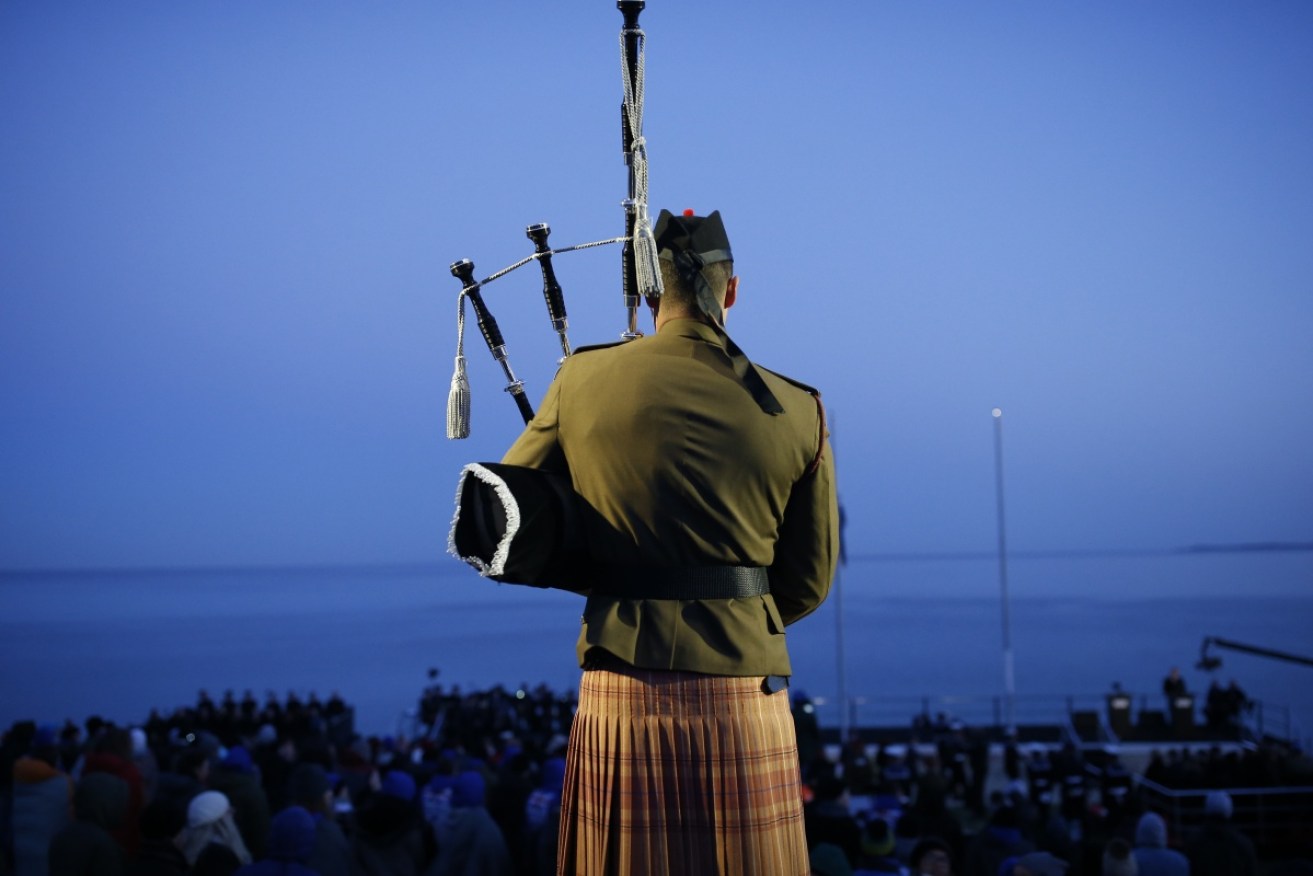Thousands mark Anzac Day in Gallipoli and Villers-Bretonneux

A bagpiper performs during the Dawn Service ceremony at Anzac Cove in Turkey. Photo: AP
Against a cold, dark sky, thousands of Australians and New Zealanders have gathered for Anzac Day dawn services in Gallipoli in Turkey and Villers-Bretonneux in France.
In Gallipoli, Foreign Minister Julie Bishop led tributes to the soldiers who served there.
She recounted the story of 16-year-old Len Hall, who spotted a girl in the crowds gathered to farewell soldiers bound for Egypt in 1915.
Mr Hall plucked an emu plume from his slouch hat and gave it to her.
Not long after, he was firing a machine gun on the Gallipoli peninsula alongside his fellow Anzacs before going on to serve in the Battle of Beersheba in Palestinian territory, and in the assault on Damascus alongside Lawrence of Arabia.
When he returned to Western Australia after the war ended in 1918, a woman approached him among the crowd of diggers taking part in a welcome home march.
“Excuse me, sir, would you like your plume back?” she asked.
The simple exchange sparked a romance, with Mr Hall later marrying Eunice and raising a family.
Ms Bishop said soldiers like Mr Hall, a West Australian who was one of the last Anzacs when he died aged 101 in 1999, had inspired generations.
“As we gather here this morning we each pay tribute to the men and women of our armed forces who have carried on the Anzac tradition for the past century and more – that spirit of courage, mateship, endurance and sacrifice that has forged our national character and identity,” she said.
“April 25 is etched into our calendar as a most sacred national day, not by a government edict or decree, but through the deep understanding of generations of Australians that this horrendous sacrifice was made in our name and for our nation, our freedoms, our democratic values and our way of life.”
Gallipoli hallowed ground: Bishop
Ms Bishop also thanked the people of Turkey for allowing Australians to commemorate the 11,400 Anzacs who died and 24,100 who were wounded during the disastrous eight-month Gallipoli campaign.

Julie Bishop speaks during the ceremony at Gallipoli. Photo: AP
Security was tight for the service after intelligence suggesting terrorists may try to target the commemorations after a string of attacks targeting tourists in Turkey.
Australian Chief of Navy Vice Admiral Tim Barrett said the Anzacs who landed at Gallipoli 102 years ago had “made a name for themselves that shines forever”.
However, he said recollections of their bravery told nothing of the fear and inner turmoil each soldier must have endured.
“Here the reality of war was shown to us. Here these men created a legend. But it was one created at great cost and great loss.”
Ambassador tells Villers-Bretonneux crowd: ‘You give it meaning’
Meanwhile, in Villers-Bretonneux, about 2130 people attended the dawn service, well down on the 3400 who attended last year.
During his address, Australia’s ambassador to France Steven Brady spoke of the importance of remembering those who had served at war.
“Official remembrance is afforded the significant resources and attention of governments, but only those remembered and those who care to remember give it meaning,” he said.
“At these treasured sites and ceremonies we want to reassure those who lost their lives, and reassure ourselves, that we will keep talking about what they did, sorting through the diaries, the letters, photographs and kit, keep trying to understand what happened. And to remember them as they would have hoped to have been remembered.”

French children tend to the graves of the Australians killed in the battle. Photo: Australian War Memorial
Australia suffered nearly 77,000 casualties on the Western Front in 1917.
Veterans Affairs Minister Dan Tehan told those gathered at the Australian War Memorial in Canberra more Australian troops died in battle that year and more were taken prisoner than in any other year of the war or in Australian wartime history.
“There has never been a year when Australia lost more to war than 1917,” he said.
Battles such as Bullecourt, Poelcappelle, Passchendaele, Polygon Wood and Messines “saw Australian lives, hopes and dreams churned into mud, blood and death”, the Minister said.








